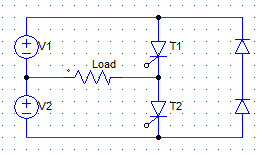This set of Power Electronics Multiple Choice Questions & Answers (MCQs) focuses on “Single Phase VSI-1”
1. Inverters converts
a) dc power to dc power
b) dc power to ac power
c) ac power to ac power
d) ac power to dc power
View Answer
Explanation: Inverter is a dc to ac converter.
2. Line-commutated inverters have
a) AC on the supply side and DC on the load side
b) AC on both supply and load side
c) DC on both supply and load side
d) DC on the supply side and AC on the load side
View Answer
Explanation: Line-commuted inverters are actually phase-controlled converters operated in the inverting mode. They cannot act as standalone inverters as they require a AC supply. It is to be noted that “line commutated inverter” is not the conventional inverter. The conventional inverters are forced or load commutated inverters.
3. In a VSI (Voltage source inverter)
a) the internal impedance of the DC source is negligible
b) the internal impedance of the DC source is very very high
c) the internal impedance of the AC source is negligible
d) the IGBTs are fired at 0 degrees.
View Answer
Explanation: A VSI is the one in which the internal impedance of the source is negligible. It has a stiff DC source at its input.
4. VSIs using GTOs are turned off by
a) load commutation
b) line commutation
c) applying a negative gate pulse
d) removing the base signal
View Answer
Explanation: GTOs are gate turn off SCRs in which turn-off is achieved by applying a negative gate pulse.
5. VSIs using IGBTs are turned off by
a) load commutation
b) line commutation
c) applying a negative gate pulse
d) removing the base signal
View Answer
Explanation: IGBT is a transistor family device. It can be turned off simply by removing the gate signal. All the transistor devices operated in the same way in inverters.
6. __________ based inverters do not require self-commutation.
a) IGBT
b) GTO
c) PMOSFET
d) SCR
View Answer
Explanation: All the devices can be turned off by their gate/base singles expect SCR. SCRs require external commutation circuits.
7. Identify the circuit given below.

a) Half wave series inverter
b) Full wave series inverter
c) Half wave bridge inverter
d) Half wave parallel inverter
View Answer
Explanation: It is a half-wave circuit as it has only 2 SCRs are connected. It is a half wave bridge type thyristorised inverter.
8. Single phase half bridge inverters requires
a) two wire ac supply
b) two wire dc supply
c) three wire ac supply
d) three wire dc supply
View Answer
Explanation: They require two voltage sources Vs/2 and Vs/2.
9. What is the voltage across the R load when only T1 is conducting?

a) Vs
b) Vs/2
c) 2Vs
d) zero
View Answer
Explanation: Considering T1 as an ideal switch, the load is directly connected to the upper voltage source when T1 is on.
10. In a single-phase half wave inverter ________ SCR(s) are/is gated at a time.
a) one
b) two
c) three
d) none of the mentioned
View Answer
Explanation: Only one SCR is gated at a time, gating the both of them will short the supply.
Sanfoundry Global Education & Learning Series – Power Electronics.
To practice all areas of Power Electronics, here is complete set of 1000+ Multiple Choice Questions and Answers.
If you find a mistake in question / option / answer, kindly take a screenshot and email to [email protected]
